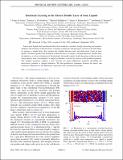Interfacial Layering in the Electric Double Layer of Ionic Liquids
Author(s)
de Souza, J Pedro; Goodwin, Zachary AH; McEldrew, Michael; Kornyshev, Alexei A; Bazant, Martin Z
DownloadPublished version (911.3Kb)
Publisher Policy
Publisher Policy
Article is made available in accordance with the publisher's policy and may be subject to US copyright law. Please refer to the publisher's site for terms of use.
Terms of use
Metadata
Show full item recordAbstract
© 2020 American Physical Society. Ions in ionic liquids and concentrated electrolytes reside in a crowded, strongly interacting environment, leading to the formation of discrete layers of charges at interfaces and spin-glass structure in the bulk. Here, we propose a simple theory that captures the coupling between steric and electrostatic forces in ionic liquids. The theory predicts the formation of discrete layers of charge at charged interfaces. Further from the interface, or at low polarization of the electrode, the model outputs slowly decaying oscillations in the charge density with a wavelength of a single ion diameter, as shown by analysis of the gradient expansion. The gradient expansion suggests a new structure for partial differential equations describing the electrostatic potential at charged interfaces. We find quantitative agreement between the theory and molecular simulations in the differential capacitance and concentration profiles.
Date issued
2020Department
Massachusetts Institute of Technology. Department of Chemical Engineering; Massachusetts Institute of Technology. Department of MathematicsJournal
Physical Review Letters
Publisher
American Physical Society (APS)